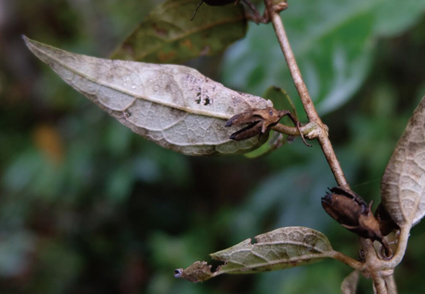Abstract
Field investigations and specimen examination revealed no obvious morphological differences among Brandisia chevalieri Bonati, B. discolor J.D.Hooker & Thomson, and B. scandens Bonati. This observation, coupled with previously established phylogenetic evidence, confirms B. chevalieri and B. scandens as synonyms of B. discolor. The issue concerning the type designation of B. discolor has been sorted out and clarified. A key to the species of Brandisia is also provided.
References
- Bennett, J.R. & Mathews, S. (2006) Phylogeny of the parasitic plant family Orobanchaceae inferred from phytochrome A. American Journal of Botany 93: 1039–1051. https://doi.org/10.3732/ajb.93.7.1039
- Bonati, G. (1924) Scrofulariacées nouvelles de l’Indo-Chine. Bulletin de la Société Botanique de France 71: 1091–1100. https://doi.org/10.1080/00378941.1924.10837015
- Chen, Z., Zhou, Z., Guo, Z.-M., Do, T.V., Sun, H. & Niu, Y. (2023) Historical development of karst evergreen broadleaved forests in East Asia has shaped the evolution of a hemiparasitic genus Brandisia (Orobanchaceae). Plant Diversity 45: 501–512. https://doi.org/10.1016/j.pld.2023.03.005
- Fischer, C.E.C. (1934) Plants new to Assam: VI. Bulletin of Miscellaneous Information, Royal Gardens, Kew 1934: 90–94. https://doi.org/10.2307/4118228
- Hemsley, W.B. (1895) CCCCLⅦ—Decades Kewenses. Bulletin of Miscellaneous Information, Royal Gardens, Kew 100–101: 114. https://doi.org/10.2307/4118319
- Hong, D.-Y., Yang, H.-B., Jin, C.-L. & Holmgren, N.H. (1998) Brandisia. In: Wu, Z.Y. & Raven, P.H. (Eds.) Flora of China, vol. 18. Science Press, Beijing & Missouri Botanical Garden Press, St. Louis, pp. 6–8.
- Hooker, J.D. (1884) The Flora of British India, vol. IV. L. Reevee & Co., London, 780 pp.
- Hooker, J.D. & Thomson, T. (1864) Description of a new genus of Scrophularineæ from Martaban. Botanical Journal of the Linnean Society 8: 11–12. https://doi.org/10.1111/j.1095-8312.1864.tb01070.x
- Li, H.-L. (1947) Relationship and taxonomy of the genus Brandisia. Journal of the Arnold Arboretum 28: 127–136.
- McNeal, J.R., Bennett, J.R., Wolfe, A.D. & Mathews, S. (2013) Phylogeny and origins of holoparasitism in Orobanchaceae. American Journal of Botany 100: 971–983. https://doi.org/10.3732/ajb.1200448
- Merrill, E.D. (1918) Notes on the flora of Loh Fau Mountain, Kwangtung province, China. The Philippine Journal of Science 13: 157–158.
- Oxelman, B., Kornhall, P., Olmstead, R.C. & Bremer, B. (2005) Further disintegration of Scrophulariaceae. Taxon 54: 411–425. https://doi.org/10.2307/25065369
- Rehder, A. (1913) Plantae Wilsonianae an enumeration of the woody plants collected in Western China for the Arnold Arboretum of Harvard University during the years 1907, 1908 and 1910 by E.H. Wilson. The university press, Cambridge, UK, 611 pp. https://doi.org/10.5962/bhl.title.191
- Smith, W.W. (1917) Diagnoses specierum novarum in herbario Horti Regii Botanici Edinburgensis cognitarum. (Species asiaticae.) CCLI-CCCL. Notes from the Royal Botanic Garden, Edinburgh 10: 10–11.
- Tsoong, P.-C. & Lu, L.-D. (1979) Brandisia. In: Tsoong, P.-C. & Yang, H.-B. (Eds.) Flora Reipublicae Popularis Sinicae, vol. 67 (2). Science Press, Beijing, pp. 17–28.
- Turland, N.J., Wiersema, J.H., Barrie, F.R., Greuter, W., Hawksworth, D.L., Herendeen, P.S., Knapp, S., Kusber, W.-H., Li, D.-Z. & Marhold, K. (2018) International Code of Nomenclature for algae, fungi, and plants (Shenzhen Code) adopted by the Nineteenth International Botanical Congress Shenzhen, China, July 2017. Regnum Vegetabile 159. Koeltz Botanical Books, Glashütten, 254 pp. https://doi.org/10.12705/Code.2018
- Xia, Z., Wen, J. & Gao, Z. (2019) Does the enigmatic Wightia belong to Paulowniaceae (Lamiales)? Frontiers in Plant Science 10: 528. https://doi.org/10.3389/fpls.2019.00528
- Yamazaki, T. (1985) Flore du Cambodge, du Laos et du Viêt-Nam: révision de la Flore générale de l’Indochine. 21. Scrophulariacées. Muséum National d’Histoire Naturelle, Paris, France, 217 pp.
- Yu, W.-B., Randle, C.P., Lu, L., Wang, H., Yang, J.-B., de Pamphilis, C.W., Corlett, R.T. & Li, D.-Z. (2018) The hemiparasitic plant Phtheirospermum (Orobanchaceae) is polyphyletic and contains cryptic species in the Hengduan Mountains of Southwest China. Frontiers in Plant Science 9: 142. https://doi.org/10.3389/fpls.2018.00142


